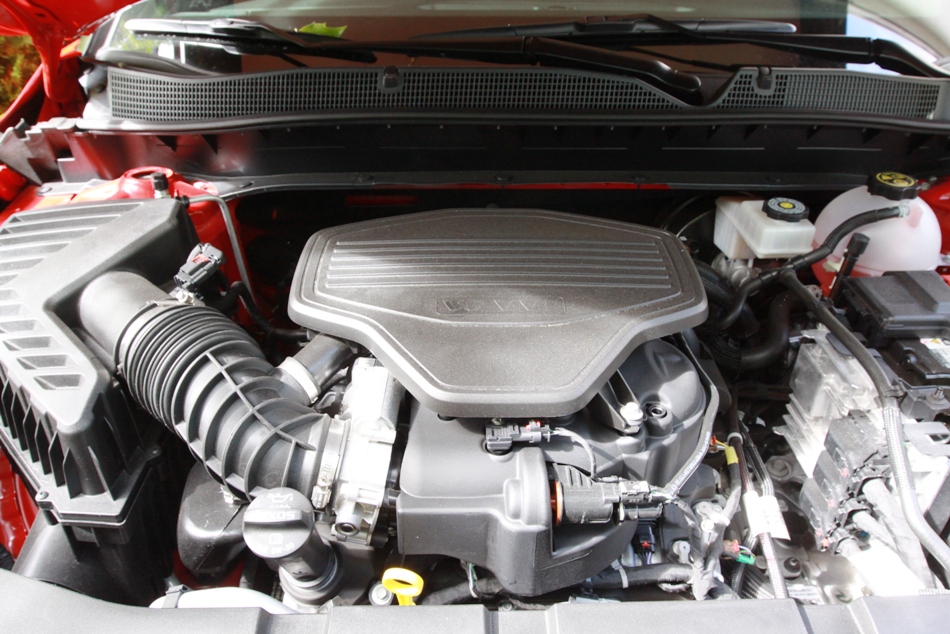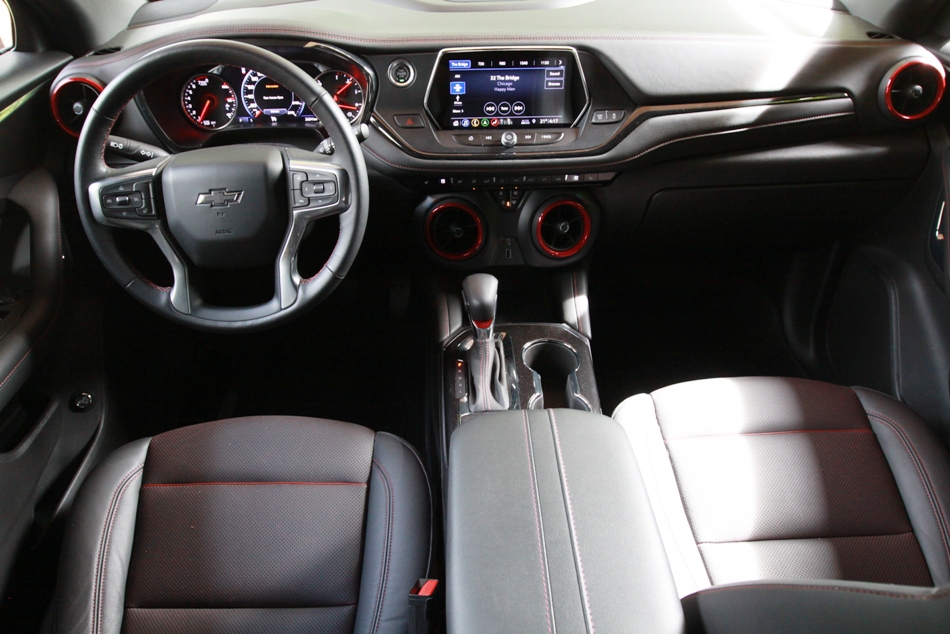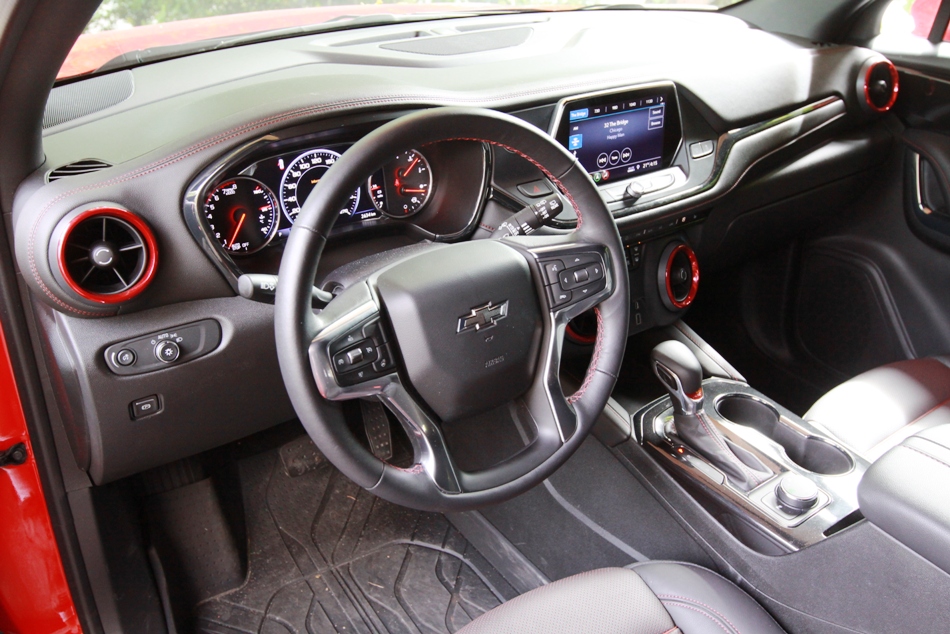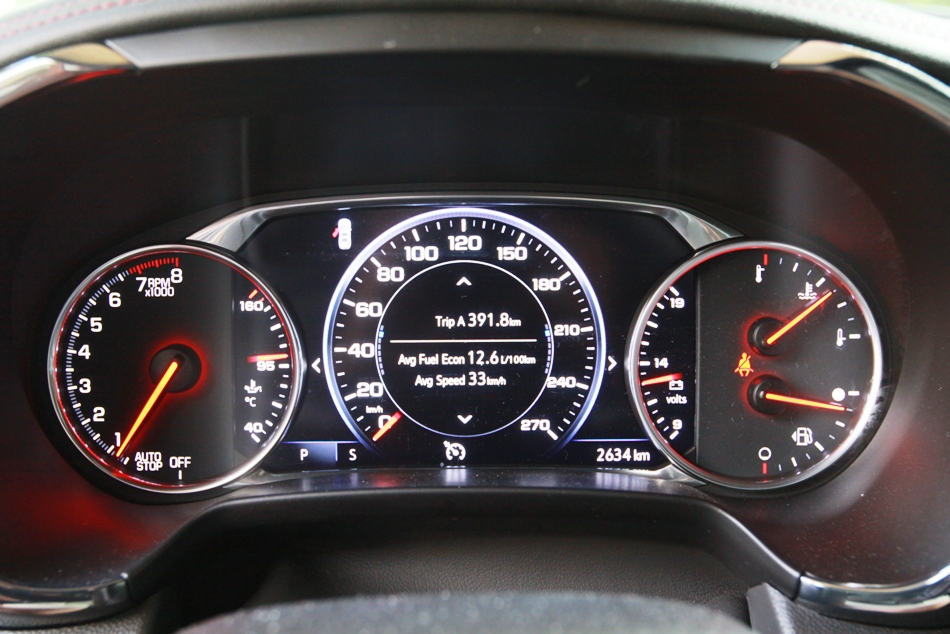The Blazer model has such a long history in Chevrolet trucks, it is surprising that it has been some 14 years since the name was last seen on a mid-size SUV. It began, of course, in 1969 as the K5 Blazer, a short-wheelbase version of the full-size pickup, one of the original truck-based SUV-type vehicles.

With so many SUV platforms in the GM product portfolio, and the growing popularity of performance-oriented SUV models, it is no surprise to see Chevrolet create a model that leans heavily on Camaro styling cues and attitude. That model is the Blazer RS. In general terms, the Blazer is a mid-size SUV based on the Traverse platform, which means it has transversely-mounted powertrains and front-wheel drive architecture, although of course, on-demand all-wheel drive is available (and standard on RS).

Our tester was slathered in bright red paint, with black-out trim including the 21-inch wheels, and all that plus the Camaro front-end treatment guaranteed a lot of swiveling heads driving down the street. It is an edgy, aggressive sort of design, and if it attracts that kind of driver to the Chevy SUV family, it will have done its job.
The base Blazers come with the 2.5-litre four and front-drive, but the RS has the 3.6-litre V6 (a Camaro engine), 9-speed automatic and on-demand all-wheel drive. It’s a proven drivetrain, smooth like any V6 and capable of moving the Blazer through traffic quite easily, especially with the 9-speed keeping it in the power band when needed. The transmission does demand that it be left to its own devices, though, as there is the PRNDL shifter gate, and nothing in the way of shift-yourself capability beyond throwing the lever into L. The driver can choose from amongst a few driving modes, though, including 2WD, 4WD, Sport, Off-Road, and Tow/Haul. We did neither of the latter two things in our time with the Blazer, so can’t comment on its capabilities, but it is rated to tow 4,500 pounds-worth of trailer.

Having said that, a naturally-aspirated V6 is something of a rarity in this age of turbo-fours and small turbo-sixes, and where it falls short is in torque, both at lower revs, and in absolute numbers at higher rpms. The RS’s natural competition, the Ford Edge ST, pumps out more than 100 lb-ft more torque at lower rpms from its 2.7-litre turbo V6, all of which makes for a noticeable difference in response out on the road.
We were impressed, though, with the handling of the RS. The big tires certainly play their part, but with the Traction Mode selector in “Sport,” the all-wheel drive engaged and directing power rearward, and the twin-clutch rear differential directing the power at the rear to the wheel with the most traction, the turn-in and steering are impressive for a 4,200-pound SUV. The steering is linear if not especially communicative, there is little body roll for an SUV, and the feeling is one of composure. There is always a compromise in that sort of performance, and in this case, the ride with the big 265/45-21 Continental tires is a little more firm than one might hope for. But hey, the RS buyer is looking for performance to go with the looks.

If the front end of the Blazer is very Camaro, then the interior certainly plays the part too. On our RS, it was mostly black, with dark red seating surfaces and some bright red trim pieces (the bezels around the air vents, mostly) to break up the darkness. The seats are perforated leather with red stitching, wide and flat to accommodate bigger people. Other soft-touch surfaces on the doors and dash are padded vinyl, so the look is one of sporty luxury.

There is plenty of room for four adults, and those in the rear seat can move it back and forth for more leg room or cargo space as needed, and recline it too. The cargo area is not as tall as some others due to the low roofline, but the floor is flat and the lift-over height low, so it is useful. Making it more so is the Cargo Management System, with rails in the floor and various attachments to secure cargo, but there is no cargo security cover included with it – for that, you need to get the Cargo Package for $290.

On the technology side, the RS is well-equipped as far as infotainment and convenience. The display measures 8-inches, and there is Navigation, Apple CarPlay and Android Auto, 4G LTE WiFi Hotspot, voice recognition, Active Noise Cancellation, SiriusXM tuner, and four USB ports. On the other hand, there are but six speakers, but more are available in the Bose premium audio – along with memory seats, power tilt-and-telescopic steering, and more – in the optional RS Plus Package for $4,395.
As far as safety goes, the RS comes with the basic safety features such as Rear Park Assist, Rear Cross Traffic Alert, and Lane Change Alert, but to get all the high-end radar-based active safety functionality, one must opt for that very same RS Plus Package, with its Adaptive Cruise Control, Surround Vision, Forward Automatic Braking, Front Pedestrian Braking, Lane Keep Assist with Lane Departure Warning, Forward Collision Alert – in other words, all the latest technology. Realistically, this equipment is must-have, so you can figure on the total price including this package.

So, just what are we looking at in terms of cost? The base RS costs $46,300. Our tester had the Sun and Wheels Package (panoramic sunroof and the big black wheels) for $2,795. The RS Plus Package is $4,395. So far, that is $53,490. Add a few of the several interior and cargo packages that are in the three-figure range, and you are looking at Blazer RS costing in the mid-$50s. Some might consider that a lot for a mainstream brand, and a two-row crossover not based on a pick-up platform.
On the other hand, style, performance and attitude, along with a name with a long heritage, have always commanded a premium price. The Blazer RS should be popular with those looking to make a big impression, while enjoying the benefits of a modern crossover.
Specifications
Price as Tested: $49,175
Engine: 3.6L DOHC V6
Power: 308 hp @ 6,600 rpm
Torque: 270 lb-ft @ 5.000 rpm
Drivetrain: All-wheel drive
Transmission: 9-speed auto
Max. Trailer Rating: 2,041 kg / 4,500 lb.
Curb Weight: 1,945 kg / 4,287 lb.
Fuel Efficiency Rating: 12.7 / 9.5 L/100 km, city/hwy
Fuel Efficiency Observed: 15.0 / 8.0 L/100 km, city/hwy




